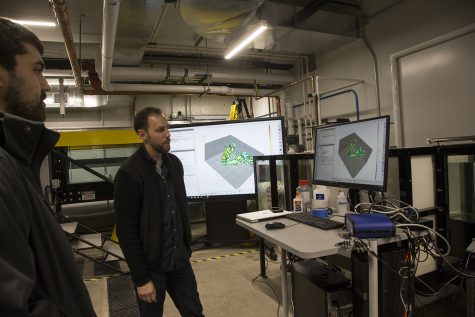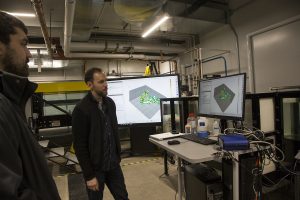UI graduate develops new heart disease prevention technology
Meeshanthini Dogan and Robert Philibert developed new technology to utilize DNA in heart disease prevention.
January 22, 2019
A UI alumna has created new technology to help manage the risk of developing coronary heart disease.
Meeshanthini Dogan was a student at the UI who completed a bachelor’s and master’s through an accelerated program in engineering. She stayed on track for a Ph.D., and she began working with psychiatry Professor Robert Philibert to answer one question: “How can I use my skills to prevent disease?”
Dogan had lost her grandfather to coronary heart disease and wanted to use her skills as an engineer to take on the problem from a different perspective.
With the help of the UI College of Engineering and Philibert, Dogan said, she was able to develop a breakthrough in heart-disease prevention.
According to an article Dogan and Phillibert published in December, “Heart disease is responsible for one in every four deaths in the United States. Coronary heart disease, which is the most common type of heart disease, results in over 350,000 deaths annually.”
The article explains that Dogan and Phillibert developed a tool to aggregate the genetic, lifestyle, and environmental risk factors using whole blood DNA-based biosignatures to look at the five-year risk for developing coronary disease.
“When you look at how your heart is accessed, doctors will look at standard risk factors,” Dogan said. “They ask your age, gender information, diabetes, cholesterol, etc. Instead of looking at these things individually, we discovered we can quantify this information.”
She said people’s DNA makeup is not modifiable; however, they can make changes in their lifestyle.
RELATED: UI study may fat in heart with heart failure
“Smoking is a major risk factor for heart disease,” Dogan said. “When you smoke, there is a change in your epigenetic signature. When you stop smoking, your site change reverts back and captures your dynamic behavior.”
Phillibert also noted the importance of technology easily capturing the smoking habits of those using cigarettes or e-cigarettes.
“It is a pretty easy differentiation to make,” he said. “We can tell what you are doing with this technology and give you the information you need to make improvements.”
The test, Dogan said, extracts DNA from one’s blood and looks at the risk signature using a propriety machine algorithm. From there, the information generates the risk model and the likelihood of symptomatic effect in the next five years.
Where the difference lies in Dogan’s technology, she said, is the sensitivity aspect of the machine.
Compared with the two most commonly used methods of technology, the Framingham Risk Score and ASCVD Pooled Cohort, Dogan said their technology is significantly more sensitive.
“The reason that sensitivity is so important is that it can truly identify your positive risk factors,” she said. “If I am at risk, I would like my physician to identify me correctly.”
The technology, she said, needed to be able to recognize both male and female heart health.
“Both men and women are at risk for [coronary heart disease] but not equal,” Dogan said. “The challenge was making sure that this tool could help both men and women, and it does.”
Dogan said another challenge she faced was conveying this information to others to get them to understand this important breakthrough and how people’s lifestyle choices are ultimately a large portion in determining whether one is at risk.
“We are very interested in substance use, as it is very preventable,” Philibert said. “The path to opioid use begins with drinking and smoking, so we are interesting in preventing the morbidity, and this is a tremendous opportunity to do so.”






















